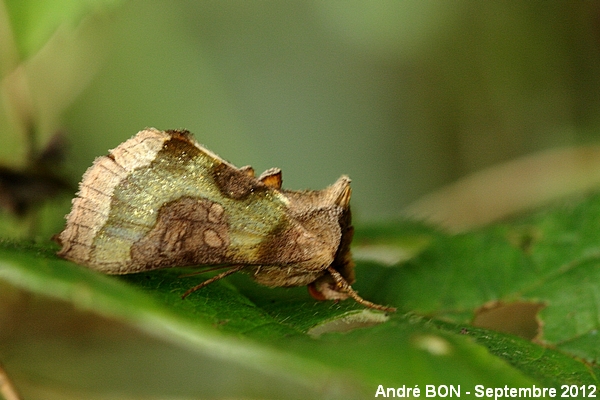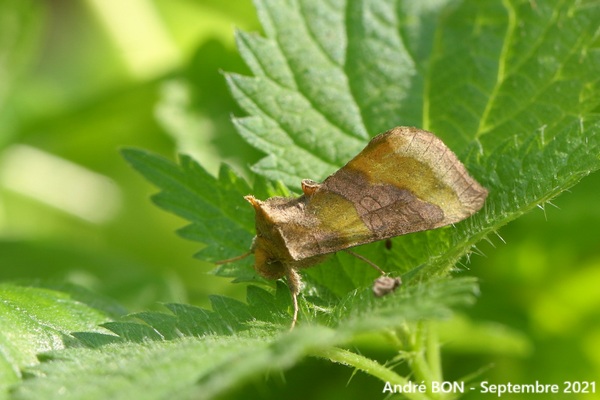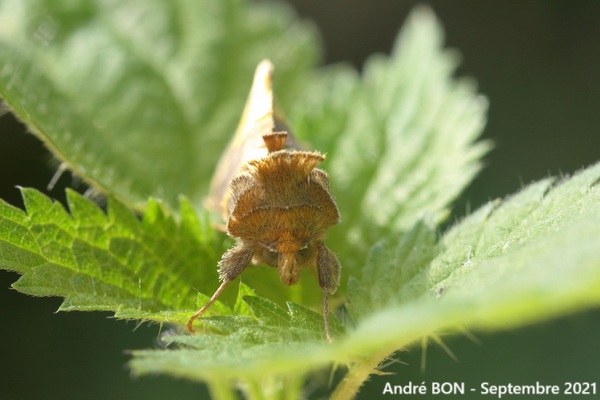




| Burnished Brass (Diachrysia chrysitis (Linnaeus, 1758)) |





|
|
Scientific name: Diachrysia chrysitis (Linnaeus, 1758) Common name: Burnished Brass French name: Plusie vert-doré Order: Lepidoptera Suborder: Heterocera Family: Noctuidae Subfamily: Plusiinae Wingspan: 28-35 mm. Biotope: Damp waste lands, gardens, marshes. Geographic area: Europe, Asia as far as eastern Siberia. Flight time: May to July then August to October. Number of generations : 2 Caterpillar: Light green with whitish chevrons on the upper side and one whitish line, bordered above with dark green, on the lateral side. The head is yellowish green. The body tapers at the front and there is only three pairs of false legs. Host plant: Many herbaceous plants, mainly the Common Nettle (Urtica dioica) but also Thistles, Dead-nettles (Lamium sp), Salvia sp, etc. |
The Burnished Brass shows reddish brown fore wings with two large metallic golden green patches separated by a broad median band. This median band is sometimes thinly interrupted in its centre, allowing a small junction between the two golden green patches (juncta form). The upper side of the head is orange. The submarginal area is pale brown. The hind wings are reddish brown. The Burnished Brass is attracted to light. It over winters as a caterpillar at an intermediate development state. There is a very similar species whose separation is sometimes contested, the Cryptic Burnished Brass (Diachrysia stenochrysis). It shows a junction between the two golden green patches like on the juncta form of the Burnished Brass. It is not possible to tell both species apart visually (nor by observation of the genitalia). You can also find Diachrysia nadeja which is recognized by the presence of a raw of small brown spots located on the veins of the submarginal area on the fore wings. |
| [To know more about the Burnished Brass] [Next picture] [Top] |

|
Here is one specimen for which we cannot tell apart the juncta form of the Burnished Brass species (Diachrysia chrysitis) from the Cryptic Burnished Brass species (Diachrysia stenochrysis). I have photographed this moth under the dark shadow of a bush. I have tried to use the flash but with very bad results because of the reflections on the beautiful metallic colours. So I have kept this picture, shot without flash light, on which there is an important moving blur. I would have appreciated a monopod or a tripod … |
| [To know more about the Burnished Brass] [Next picture] [Previous picture] [Top] |

|
Here is a new observation with better light conditions. Here the two golden-green areas are clearly separated by the wide brown median band. |
| [To know more about the Burnished Brass] [Next picture] [Previous picture] [Top] |

|
Top view, wings spread. |
| [To know more about the Burnished Brass] [Next picture] [Previous picture] [Top] |

|
Top view, wings folded. |
| [To know more about the Burnished Brass] [Previous picture] [Top] |

|
Front view. |